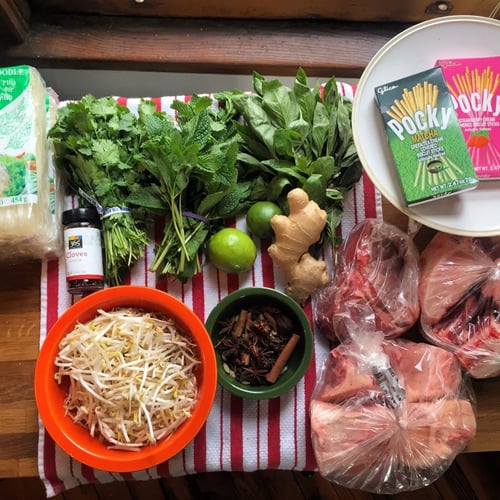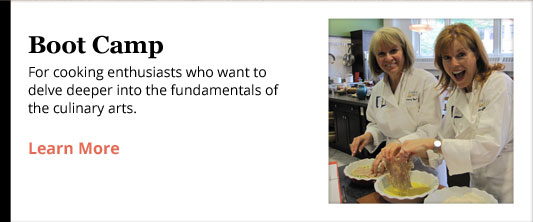As we enter the post-holiday period when the seemingly endless supply of Christmas cookies disappears and aspirational resolutions are looming, we Midwestern food lovers have to find ways to fill our time during the cold, short days. I find that on the fortuitous weekends when I have a free afternoon and it’s so cold that I would rather stay in anyway, it’s nice to embark on a cooking project. To me, a worthy cooking project is something outside my normal cooking routine, whether it be a complex bread, braise or, in this case, Vietnamese phở.
 After first trying Vietnamese food in college, the cuisine quickly sky rocketed to the top of my “favorite foods” list. From savory, comforting phở to the incredible mix of flavors and textures in vermicelli noodle bowls (bún), I will gladly go for Vietnamese food every night of the week. But what about trying phở at home? That’s the question that struck me late last winter when I craved phở on a cold Saturday afternoon.
After first trying Vietnamese food in college, the cuisine quickly sky rocketed to the top of my “favorite foods” list. From savory, comforting phở to the incredible mix of flavors and textures in vermicelli noodle bowls (bún), I will gladly go for Vietnamese food every night of the week. But what about trying phở at home? That’s the question that struck me late last winter when I craved phở on a cold Saturday afternoon.
Luckily, my boyfriend gifted me Andrea Nguyen’s “Into the Vietnamese Kitchen” last Christmas as a challenge to stretch my cooking chops and learn how to make some of my favorite dishes at home. Nguyen’s book has been widely regarded as one of the best English resources for Vietnamese recipes and techniques. Her book breaks down common Vietnamese ingredients, recipes and cooking techniques to make even the most obscure dish accessible to the home cook.
As I examined Nguyen’s recipe for beef phở, I quickly realized that my dreams of holing up in the house were but a pipe dream. I needed 5 pounds of beef leg bones, star anise, yellow rock sugar and Thai basil, just to name a few ingredients that I certainly did not have laying around the kitchen. I donned my winter coats (over sweatpants, no need to get too uncomfortable) and headed up to Tai Nam Market on Argyle to gather the ingredients.
Now, here’s where you stop to ask: Leigh, why didn’t you just go out for phở once you decided to leave the house? You may continue to wonder: Leigh, how do you plan to dispose of the beef bones once simmered? Won’t you get hungry since phở takes several hours to make? And last but not least, did you think about the fact that you don’t have a pot big enough to fit all of this? Worthy questions, dear reader, but at that point, I had already made up my mind about the phở project and no matter what, it was happening.
After a successful trip up to Argyle to gather the ingredients (including a new, large stock pot), I began to follow Nguyen’s recipe to get the broth started. The broth is, by far, the hardest part of making a bowl of phở and it takes quite some time to build the flavor through the bones and spices. Nguyen’s recipe is quite detailed and walks you through every step of the hours-long process. A similar recipe to the one found in her book is posted on her website, Viet World Kitchen. I would highly recommend both her book and this recipe if you ever plan to pursue a phở cooking project!
So, how did the phở cooking project fare? A few hours in, I felt so optimistic that I prematurely invited a friend over for dinner that night. Despite the fact that we didn’t eat until close to 9pm and the first batch of noodles was massively undercooked, the end result was delicious. So delicious (and copious) in fact, that I froze about a gallon of broth for another day when I couldn’t even muster the energy to walk to Argyle (now just a short distance from my new apartment). The broth was so prized due to both it’s flavor and the labor time that it received a special trip from my old apartment to my new place, so as not to melt during the passage.
I recently found myself in need of satisfying a phở craving without the wherewithal to venture out to Argyle. I defrosted the broth and enjoyed my own phở at home yet again. My phở cooking project was much more involved than I initially anticipated but the joy and satisfaction of the effort a few months later made everything worth it. Will I try phở again this winter? I am not sure yet. But I will certainly be trying more recipes from Nguyen’s books.
If you’re interested in learning the techniques of stock making and working with meat, check out The Chopping Block’s Culinary Boot Camp. Starting in 2016, we are offering Boot Camp “A la Carte”, where you can pick and choose particular days of boot camps if you want to master a particular skill or don’t have time to commit to the whole program. Day 2 has “cooking project” written all over it: you’ll learn about chicken and beef butchery, stock making, braising, sautéing, stuffing and roasting. After Boot Camp Day 2, you’ll have an arsenal of skills to fill up the remaining cold, dark winter days. Happy holidays and as always, happy cooking!


